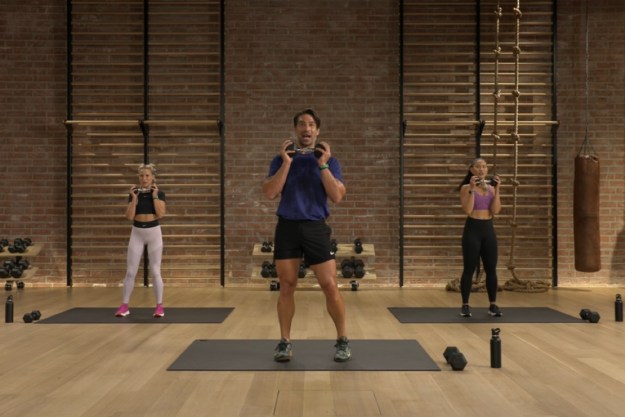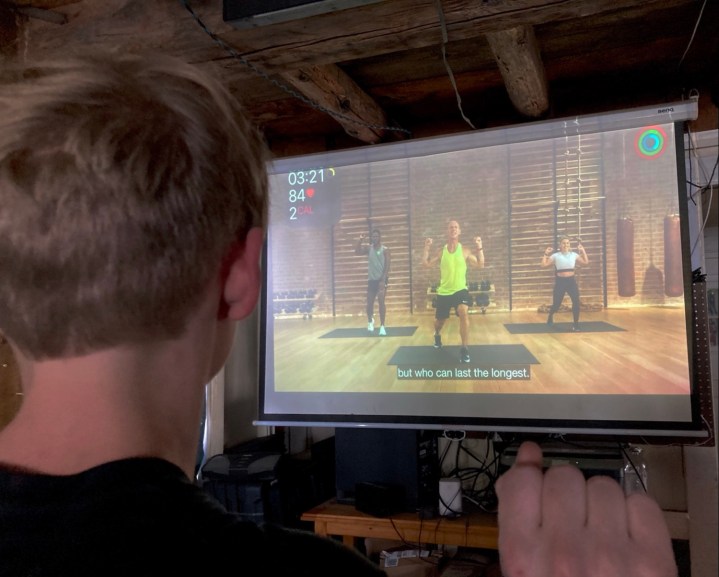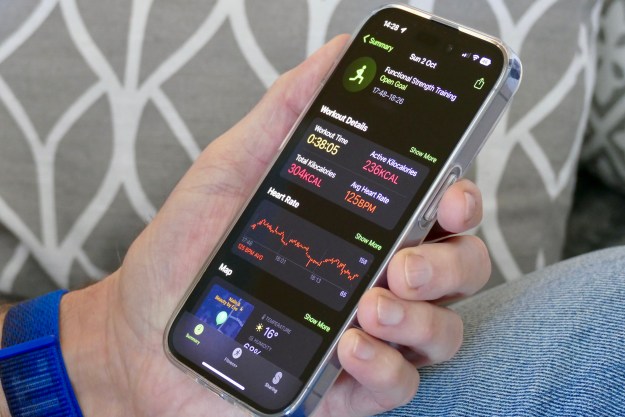
“Fitness+ motivates you to close your activity rings, but is lacking in key areas”
- Seamless integration with the Apple Watch
- Diversity of likable trainers
- Variety of workout types
- New content every week
- Requires an Apple Watch Series 3 or newer and an iPhone
- No live classes
- Some exercises require specific equipment
Because of gym restrictions and pandemic concerns, many people are building their own home gym instead of dropping their hard-earned money on a gym membership. Services like Apple Fitness+ are stepping in to fill this void as the shift to at-home fitness transforms the fitness industry. Can an online stream replace your in-person Pilates class? We tested Apple Fitness+ to find out.
Apple Watch is the killer feature
Apple Fitness+ is available for the iPad, iPhone, and Apple TV, but it really was designed for the Apple Watch. As soon as you open a workout on your iPhone, it immediately shows up on the Apple Watch. Your watch then sends your health data to your connected device so you can view it as you follow the trainer’s lead.
I found myself connecting with the trainers and wanting to exercise with them.
While you are exercising, you can watch your activity rings increase as you get closer to completing your workout goals. You also can see your heart rate, time, and calories burned. It’s a small feature, but incredibly motivating to see all your stats on the big screen. Because it’s on your screen, you don’t have to keep glancing down at your Watch. This is huge for someone like me who is likely to stumble or lose the rhythm by looking at my wrist.
Can’t-do vibe
Apple Fitness+ is excellent for beginner to midlevel athletes, just as long as they have the right gear. Most cardio workouts require a treadmill, bike, or stepper machine, and they are not interchangeable. Unlike iFit, which films landscape-based activities suitable for any machine, Fitness+ requires you to have a bike to do the cycling workouts, for example.

You’ll also need dumbbells or kettlebells to complete many of the strength activities. You may be able to swap out bodyweight exercises, but it is not the same. You also can skip those workouts that require specific gear, but eliminating so many exercises considerably diminished my experience. Instead of having a “can-do” feeling, I often had a “can’t-do” feeling as I browsed through the workout library. To be fair, Apple does offer walking workouts and dance classes that don’t require any special gear, but these are few and far between. I would love to see more of this creative, gear-free content.
This “can’t-do” feeling was exacerbated by a limited user interface. Fitness+ sorts the workouts into broad categories (high-intensity interval training, yoga, core, strength, treadmill, cycling, rowing, dance, and mindful cooldown) to help you find the right exercise. ut once inside a category, I found it challenging to find the right workout for my fitness level. There was no way to filter activities based on the difficulty level or gear it required. I had to choose a workout and then read the description to figure out if it was appropriate for me. This hunt-and-peck method of finding an activity was tedious.
Diverse, enthusiastic trainers
Apple is the master of appearance, so it’s no surprise that the Fitness+ videos are highly polished. The videos are filmed in a gorgeous studio gym with great camera angles so you can see exactly how the trainer is moving. The workouts offer upbeat music and likable trainers who encourage you to “close those rings.”
There is no way to filter activities and the hunt-and-peck method of finding a workout was tedious.
Apple’s trainers reflect a variety of different ethnicities, ages, and body types, which I appreciated. Because they were normal and not super-fit elite athletes, I found myself connecting with the trainers and wanting to exercise with them. Their enthusiasm was infectious. Apple also adds content weekly, which keeps me coming back to find out what’s new.
Moderate workouts, but no live content
Fitness+ is geared toward the massive number of iPhone and Apple Watch owners. It targets the beginner-to-midlevel person and not advanced athletes. Established fitness fanatics could use Fitness+ to supplement their existing routine or for cross-training on a rest day, but it won’t replace their existing high-intensity routine.
Most workouts are simple to follow and some are even scalable, which is a feature other exercise programs should adopt. In these scalable strength workouts, you can choose to complete the selected activities, pump it up a notch with advanced activities, or scale down the exercises if you have an injury or just want to take it easy. This flexibility encourages you to keep going even when an injury or an illness gets in the way.
As much as I enjoyed Fitness+, the service has a major Achilles’ heel. Unlike Peloton or Mirror, which offer an abundance of live classes, Apple Fitness+, unfortunately, is comprised entirely of prerecorded videos. On-demand workouts are convenient because you can exercise anytime you want, but they lack the communal feel of a live class. Hopefully, Apple will bring on a few trainers to lead live classes on a daily basis.
Cost
Apple Fitness + requires an Apple Watch Series 3 or newer, which will set you back at least $199 for a new Watch. It also requires a $10 monthly or a $80 yearly subscription. The service is also included in the Apple One Premier bundle, which costs $30 per month and includes Apple Music, Apple TV+, Apple Arcade, Cloud, and News+. When it comes to cost, it’s significantly cheaper than the average $40 per month subscription that most connected home gyms like Mirror, Tempo Studio, and Tonal require.

Our take
Apple Fitness+ is a great workout tool for the beginner to midlevel Apple fan who already owns an Apple Watch. A growing library of workouts from motivating trainers encourages you to exercise. It’s a little rough around the edges, but it has potential. If Apple listens to its critics and improves the service, Fitness+ could give Peloton a run for its money in the coming year.
Is there a better alternative?
Apple Fitness+ shows promise, but it requires an Apple Watch. Not everyone owns an Apple Watch, nor wants to buy one just to workout. The strongest competitor to Fitness+ is iFit, which has an extensive library of prerecorded studio and outdoor activities and a growing number of live workouts, and does not require a fitness watch. It’s competitively priced at $10 monthly and runs on tablet or smartphone.
How long will it last?
Apple has a history of supporting and upgrading the software on its older devices, and we expect Apple Fitness+ to receive the same treatment. The service will improve over time, and its deficiencies (no live workouts, for example) will be a thing of the past.
Should you buy it?
Yes, Apple Fitness+ may be just what the doctor ordered for Apple Watch owners looking to get fit and stay fit.
Editors' Recommendations
- Best Apple Watch 8 deals: Save on last year’s model
- Do iPhone 14 cases fit the iPhone 15? Sort of, but not quite
- The best iPhone 15 Plus cases in 2024: 15 best ones right now
- Apple has an iPad shocker planned for early 2024
- Here’s our first look at OnePlus’ next Apple Watch killer







